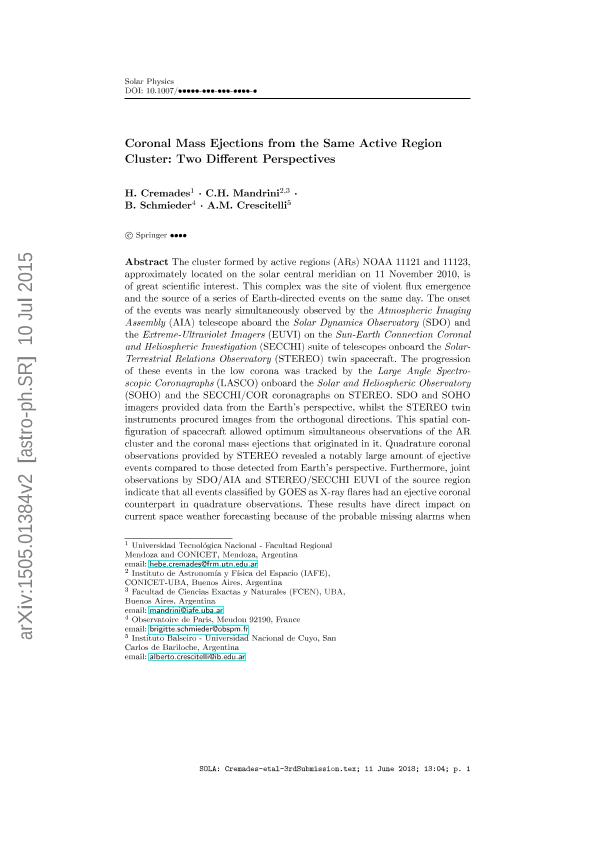Mostrar el registro sencillo del ítem
dc.contributor.author
Cremades Fernandez, Maria Hebe

dc.contributor.author
Mandrini, Cristina Hemilse

dc.contributor.author
Schmieder, B.
dc.contributor.author
Crescitelli, A. M.
dc.date.available
2019-07-30T18:34:59Z
dc.date.issued
2015-06
dc.identifier.citation
Cremades Fernandez, Maria Hebe; Mandrini, Cristina Hemilse; Schmieder, B.; Crescitelli, A. M.; Coronal Mass Ejections from the Same Active Region Cluster: Two Different Perspectives; Springer; Solar Physics; 290; 6; 6-2015; 1671-1686
dc.identifier.issn
0038-0938
dc.identifier.uri
http://hdl.handle.net/11336/80602
dc.description.abstract
The cluster formed by active regions (ARs) NOAA 11121 and 11123, approximately located on the solar central meridian on 11 November 2010, is of great scientific interest. This complex was the site of violent flux emergence and the source of a series of Earth-directed events on the same day. The onset of the events was nearly simultaneously observed by the Atmospheric Imaging Assembly (AIA) telescope onboard the Solar Dynamics Observatory (SDO) and the Extreme-Ultraviolet Imagers (EUVI) on the Sun-Earth Connection Coronal and Heliospheric Investigation (SECCHI) suite of telescopes onboard the Solar-Terrestrial Relations Observatory (STEREO) twin spacecraft. The progression of these events in the low corona was tracked by the Large Angle Spectroscopic Coronagraphs (LASCO) onboard the Solar and Heliospheric Observatory (SOHO) and the SECCHI/COR coronagraphs on STEREO. SDO and SOHO imagers provided data from the Earth’s perspective, whilst the STEREO twin instruments procured images from the orthogonal directions. This spatial configuration of spacecraft allowed optimum simultaneous observations of the AR cluster and the coronal mass ejections that originated in it. Quadrature coronal observations provided by STEREO revealed many more ejective events than were detected from Earth. Furthermore, joint observations by SDO/AIA and STEREO/SECCHI EUVI of the source region indicate that all events classified by GOES as X-ray flares had an ejective coronal counterpart in quadrature observations. These results directly affect current space weather forecasting because alarms might be missed when there is a lack of solar observations in a view direction perpendicular to the Sun-Earth line.
dc.format
application/pdf
dc.language.iso
eng
dc.publisher
Springer

dc.rights
info:eu-repo/semantics/openAccess
dc.rights.uri
https://creativecommons.org/licenses/by-nc-sa/2.5/ar/
dc.subject
Initiation And Propagation
dc.subject
Coronal Mass Ejections
dc.subject
Prominences, Dynamics
dc.subject
Low Coronal Signatures
dc.subject.classification
Astronomía

dc.subject.classification
Ciencias Físicas

dc.subject.classification
CIENCIAS NATURALES Y EXACTAS

dc.title
Coronal Mass Ejections from the Same Active Region Cluster: Two Different Perspectives
dc.type
info:eu-repo/semantics/article
dc.type
info:ar-repo/semantics/artículo
dc.type
info:eu-repo/semantics/publishedVersion
dc.date.updated
2019-05-14T21:36:16Z
dc.journal.volume
290
dc.journal.number
6
dc.journal.pagination
1671-1686
dc.journal.pais
Alemania

dc.journal.ciudad
Berlin
dc.description.fil
Fil: Cremades Fernandez, Maria Hebe. Consejo Nacional de Investigaciones Científicas y Técnicas. Centro Científico Tecnológico Conicet - Mendoza; Argentina. Universidad Tecnológica Nacional. Facultad Regional Mendoza; Argentina
dc.description.fil
Fil: Mandrini, Cristina Hemilse. Consejo Nacional de Investigaciónes Científicas y Técnicas. Oficina de Coordinación Administrativa Ciudad Universitaria. Instituto de Astronomía y Física del Espacio. - Universidad de Buenos Aires. Facultad de Ciencias Exactas y Naturales. Instituto de Astronomía y Física del Espacio; Argentina. Universidad de Buenos Aires. Facultad de Ciencias Exactas y Naturales; Argentina
dc.description.fil
Fil: Schmieder, B.. Centre National de la Recherche Scientifique. Observatoire de Paris; Francia
dc.description.fil
Fil: Crescitelli, A. M.. Comisión Nacional de Energía Atómica. Gerencia del Área de Energía Nuclear. Instituto Balseiro; Argentina
dc.journal.title
Solar Physics

dc.relation.alternativeid
info:eu-repo/semantics/altIdentifier/url/https://arxiv.org/pdf/1505.01384.pdf
dc.relation.alternativeid
info:eu-repo/semantics/altIdentifier/url/https://link.springer.com/article/10.1007/s11207-015-0717-9
dc.relation.alternativeid
info:eu-repo/semantics/altIdentifier/doi/http://dx.doi.org/10.1007/s11207-015-0717-9
Archivos asociados
